As a direct-to-consumer pioneer, the Cleveland-based manufacturer-retailer continues its tradition of hand-built, quality mattresses with low-pressure sales.
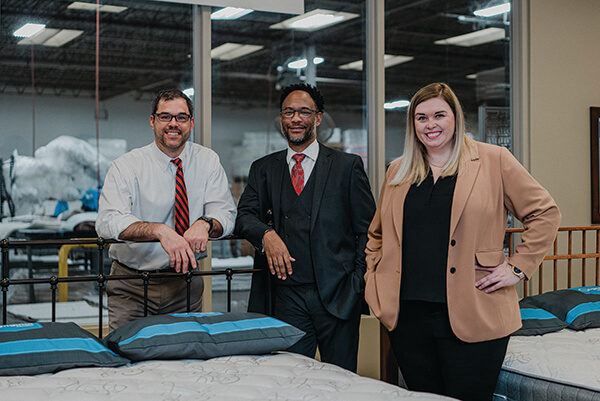
PHOTOGRAPHY BY Owen Zubek
Internet-based mattress brands that sell direct to consumer have gotten a lot of buzz — and siphoned off a lot of sales from traditional bedding retailers. The trend has accelerated with the Covid-19 pandemic.
But long before those digital natives debuted, The Original Mattress Factory was a pioneer in direct-to-consumer sales through a successful manufacturer-retailer model it began honing more than 30 years ago, says Kristen Hastings, director of corporate marketing for the Cleveland-based company.
While its direct-to-consumer competitors may focus on marketing and branding, The Original Mattress Factory concentrates on manufacturing high-quality products — hand built one at a time in company-owned factories — and selling them to consumers in a low-pressure environment.
“For us, it’s about offering the best products at a great value every day and providing a consultative sales approach that helps the customer make the right smart buying decision for them,” Hastings says.
Today, the company operates 12 factories and more than 100 stores in nine states, as well as a robust e-commerce site.
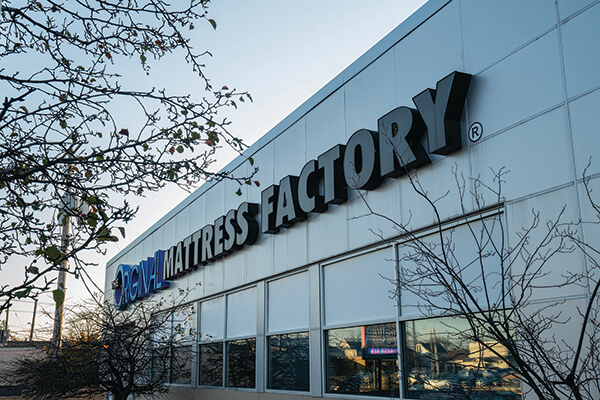
A New Chapter for The Original Mattress Factory
The Original Mattress Factory was founded by Greg Trzcinski’s father, Ron Trzcinski, who had been president and chief operating officer of bedding brands Sealy and Stearns & Foster. Ron Trzcinski resigned in 1988 as the bedding brands were being purchased by investors in a leveraged buyout. He then partnered with two other bedding industry veterans, Larry Carlson and Perry Doermann, to open The Original Mattress Factory as a factory and showroom in Cleveland in 1990. A year later, another industry veteran, Doug Stroup, joined the original leadership trio.
“My father didn’t want to be part of the leveraged buyout. He didn’t like the ‘cash is king’ philosophy,” says Greg Trzcinski, who joined the company in 2000 and became president and chief executive officer in 2018 when his father retired. “He didn’t know exactly what he was going to do next but then he came up with the idea of taking mattress manufacturing and mattress buying to the next level, focused on the customer.”
The company expanded to other cities in Ohio and then began spreading into other states in a fashion that, at first glance, might seem haphazard: Georgia, then Minnesota, then North Carolina. The Original Mattress Factory now operates in those states, as well as Florida, Kentucky, Pennsylvania, South Carolina and Virginia.
“When my father was running things, he hired people that he or one of his associates had known, worked with and trusted. So that’s how we got into what may look like an erratic expansion model. Expansion for us started with the right people. As a factory-direct, he looked for people who understood local markets and expanded there,” Trzcinski says.
In 2011, The Original Mattress Factory began to move toward an employee ownership model and, in 2017, started operating fully through an employee stock ownership plan. “As an ESOP, we have over 400 employee-owners,” Trzcinski says. “It’s all of us working together.”
Handcrafted Mattresses, Built to Your Specifications
As a manufacturer-retailer, The Original Mattress Factory uses a hub-and-spoke system, with one production plant (typically about 35,000 square feet) serving five to 15 retail showrooms within a radius of about 60 miles. Its factories and retail showrooms are wholly owned and operated by the company.
The company continues to expand and recently opened a factory in Tampa, Florida, which will serve stores in that growing market.
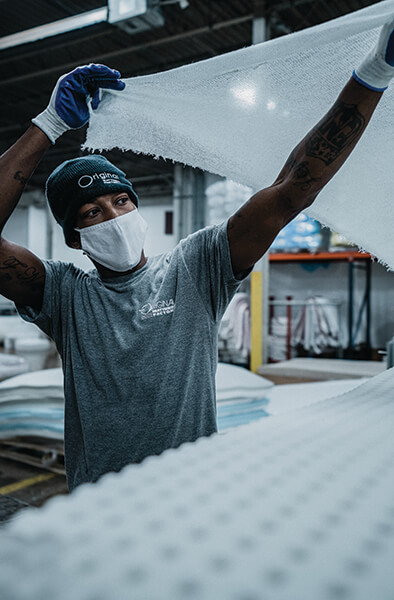
“We’re always looking to grow but we don’t have plans to grow for growth’s sake,” Trzcinski says. “We’re very focused on growing the right way — expanding locally and into new markets when it makes sense, when we have the right people and a good market to step into.”
The Original Mattress Factory prides itself on being transparent about its products and manufacturing process, encouraging consumers to visit the local factory to see how beds are made. Even if they never visit a plant, customers can get a glimpse into the company’s methods through the Mattress 101 section of each retail location, which features educational videos and demonstrations, such as cutaways of mattress models, that help retail sales associates explain bed constructions and the benefits of components.
“We’re not afraid to show you everything,” Trzcinski says. What consumers will find inside the company’s products include traditional box springs, edge-to-edge innerspring units, high-density foams, cotton padding and other high-quality components. Most mattresses are two-sided.
Beds are made to order, one at a time in each factory, and as a quality control measure, each day factories “take apart an entire set and evaluate everything every operator was supposed to do,” Trzcinski says. “It’s a quality check: Did we do what we were supposed to do?”
Your Foundation for a Good Night’s Sleep
The company’s showrooms have a simple, uniform decor of restful dark blues and tans. Nightstands, framed paintings, table lamps, headboards and other touches soften the spaces but the emphasis is on the bed sets.
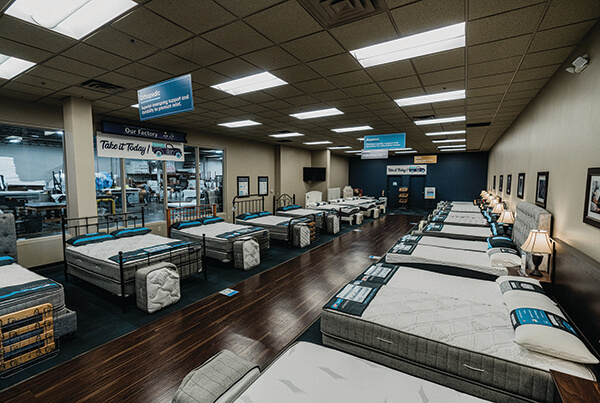
“It’s a warm, welcoming environment,” Hastings says. “It’s all about the customer, and we want them to feel comfortable.”
Retail locations typically are 3,000 square feet, with 2,500 square feet devoted to the showroom. Each store carries the same product assortment — 18 Original Mattress Factory beds color-coded by product line to create a logical sales presentation that’s easy for shoppers to understand. Signage is limited and focused on giving shoppers the information they need to compare the features and benefits of beds. “Every mattress we carry serves a purpose and meets a customer need so they all sell well,” Hastings says.
Retail prices range from $470 for a queen-size two-sided mattress set to $2,479 for a king-size latex set. But Original Mattress Factory executives are quick to say that equating its prices to competitors’ prices is an apples to oranges comparison. “Our beds look and feel like nothing else out there,” Hastings says. “People think we compete with discounters, but we don’t. Because of the quality of our products, we compete with high-end manufacturers. We build a better bed for less.” As a manufacturer-retailer, The Original Mattress Factory also offers custom mattress sizes, as well as specialty mattresses for antique bed frames, boats, campers, RVs and other uses.
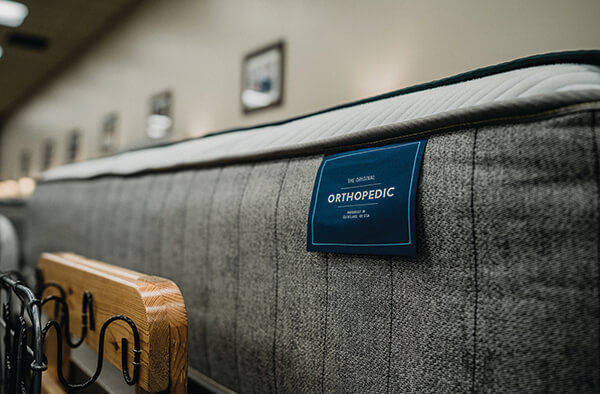
The Original Mattress Factory carries a full range of bedding accessories, including headboards from Eastwood Furniture and Hillsdale Furniture, pillows from Carpenter Co. and Talalay Global, sheets from DreamFit, protectors from Protect-A-Bed, frames from Rize and adjustable bases from Leggett & Platt Inc.
Accessories are offered as a convenience to shoppers but aren’t pushed or heavily promoted by RSAs. “We want to make it easy for a customer to do one-stop shopping,” says David Phillips, an Original Mattress Factory sales and marketing partner in Cleveland who has been with the company for more than 20 years. “If someone is in the market for a good protector or pillow, we want to be able to offer them a high-quality product at a great price. But we’re here to sell mattresses and box springs.”
The Original Mattress Factory shuns the “Sale! Sale! Sale!” model favored by many mattress retailers. “None of our locations has ever held a sale or done a giveaway,” Trzcinski says. “We offer the very best price to our customers every single day. We are very transparent in terms of pricing and product.”
RSAs aren’t encouraged to step shoppers up into pricier models. “We don’t try to upsell,” Trzcinski adds. “It’s all about the relationship and working with customers to find out what they need.”
Empowering Consumers Through Education
Given those philosophies, it’s not surprising that the in-store sales process is consultative, low-pressure and focused on educating shoppers about mattresses — whether they end up buying from the company or not. On its website, it promises customers they will “Walk in a mattress customer. Leave a mattress industry insider.”
“Our repeat and referral business is so high because our no-pressure approach makes people feel comfortable,” Hastings says.
Prices are clearly marked on the footers of each bed, and the same signage lifts up to provide product details in a clear, uniform format that makes comparing models quick and easy for shoppers. “We know mattress shopping can be stressful and confusing,” Phillips says. “We try to keep it simple.”
Some mattress retailers encourage RSAs to follow a sales script and to start all shoppers off on a specific trio of high-end models to assess shoppers’ comfort preferences. That’s not the case at The Original Mattress Factory. Typically, the company’s RSAs give an overview of the company’s four mattress lines and use the Mattress 101 display to explain its manufacturing process and use of quality components. Then they’ll turn to determining customers’ comfort preferences, typically using a medium soft and a medium firm mattress as initial rest-testing models. But each sales conversation is unique and driven by the customer.
“We want our people to be dynamic, to think on their feet and to take their cues from the customer,” Phillips says. Such a sales strategy requires a different kind of training and in-depth educational process that teaches RSAs not only about the company’s products but the entire mattress industry.
“If I were to hire you as an RSA today, you’d do some paperwork and get an introduction to the company and then I’d send you shopping for three days,” Phillips says. “I’d say: ‘Go shop one of our stores. Go shop the competitors and on the fourth day, come back and we’ll talk about which stores you liked and which store you’d buy from.’ That’s the groundwork we lay. Our approach to sales is educational, so we want to educate RSAs on the industry and the products. We want customers to be armed with good information.”
The RSA training period lasts 90 days, during which new hires work with seasoned staff as they continue to learn and develop their own selling style. Regular continuing education keeps all RSAs engaged and up to date, Hastings says.
Staff turnover is low and RSAs “stay motivated because they are confident that they are helping people,” Trzcinski says. “If you were to ask a sales associate what’s rewarding about their job, they would say a comment a customer has made about the level of customer service they received or the quality of the product,” he says. “That’s why they are motivated to get up and come to work — not because of quotas, which we don’t have, but because they want to help customers.”
Company executives, Trzcinski adds, take turns working the sales floor on nights and weekends “to stay close to the business” so they can better understand the needs of customers.
A Customer-Centric Approach to Sleep
An omnichannel retailer, The Original Mattress Factory has a robust e-commerce site that mirrors its retail operation in terms of branding and product offerings. Prices are always the same online and in-store.
“We focus on keeping our website easy to navigate and to translate the in-store experience online,” Hastings says.
The company sees e-commerce as a complement — not competitor — to its retail locations.
“We always recommend that someone come in to try a bed before buying,” Trzcinski says. “It’s less about our beds changing because we don’t reintroduce our whole line every 12 to 18 months like others. It’s because our bodies and needs change over time. But we don’t push people to visit a store. Our customers can buy in-store, online or over the phone, whatever they prefer.”
The Original Mattress Factory doesn’t offer free delivery — a common retail practice that Trzcinski says hides the cost of delivery in higher mattress prices and would be unfair to the company’s cash-and-carry customers. Instead, the company charges for delivery, with fees based on ZIP code starting at $65. Customers pay an additional $5 per piece to have delivery teams bag, seal and remove used bedding from their home. For customers outside local delivery zones, the company offers white-glove delivery via a third-party shipping company starting at $199. Online orders, which have increased since the Covid-19 pandemic began, are fulfilled by the closest local factory and delivered by local stores or by third-party carrier.
Any customer problems, including service of adjustable bases, are handled directly by The Original Mattress Factory. “The customer is entrusting us with the sale, so we should be the first person they contact if they have a problem,” Phillips says.
The Original Mattress Factory’s tendency to shun many industry trends and follow a strategy based on core principals of making quality products and serving customers has served the company well for three decades, Trzcinski says.
“There was nobody like us in the mattress industry when we opened in 1990,” he says, “and there’s nobody like us today.”
Learn how Therapedic’s innovative marketing strategies win them customers: One Brand, Three Ways: How Therapedic International Markets Its Products Around the World.






